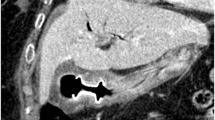Abstract
Traditional open cholecystectomy became the “gold standard” of surgical treatment for symptomatic gallstone disease during the last century. In spite of its good results, clinicians have been trying to establish effective nonsurgical methods of eliminating gallstones. Although oral, percutaneous, or retrograde litholysis can be used effectively for cholesterol stones, these represent only 10% of all gallstones. Moreover, intracorporeal lithotripsy is an invasive method, and while extracorporeal shock wave lithotripsy is a promising procedure, even after careful selection, only 70%–80% of the patients become stone-free within 1 year. In fact, none of the methods which leave the gallbladder intact are free of complications, and they are followed by 50% stone recurrence within 5 years. Since 1987, laparoscopic cholecystectomy has become the procedure of choice as it is safe and only minimally invasive. We believe that the laparoscopic technique is a promising way to the surgery of the future.
Similar content being viewed by others
References
Rewbridge AG (1937) The disappearance of gallstone shadows following prolonged administration of bile salts. Surgery 1:10–15
Johnston CG, Nakayama F (1957) Solubility of cholesterol and gallstones in metabolic material. Arch Surg 75:436–442
Danzinger RG, Hofmann AF, Schoenfield JL, Thistle JL (1972) Dissolution of cholesterol gallstones by chenodeoxycholic acid. N Engl J Med 286:1–8
Iwasaki T (1936) Über die Konstitution der Ursodesoxycholsäure. Z Physiol Chem 244:181–193
Makino I, Shinozaki K, Yoshino K, Nakagawa S (1975) Dissolution of cholesterol gallstones by ursodeoxycholic acid. Nippon Shokakibyo Gakkai Zasshi (Jpn J Gastroenterol) 72:690–702
Smit JWA, Erpecum KJ, Stolk MFJ (1992) Successful dissolution of cholesterol gallstone during treatment with pravastatin. Gastroenterology 103:1068–1070
Allen MJ, Borody TJ, Bugliosi TF, May GR, Larussoi NF, Thistle JL (1985) Cholelitholysis using methyl tertiary butyl ether. Gastroenterology 88:122–125
Leuschner U, Hellstern A, Ansell A, Gatzen M (1994) Manual and automatic gallstone dissolution with methyl tert-butyl ether. Dig Dis Sci 39:1302–1308
Swobodnik W, Ditschuneit H, Soloway RD (1990) Gallstone disease. Springer, Berlin Heidelberg New York
Moriyasu A, Ise H, Noriyoshi S, Matsuno S (1994) Treatment of cholelithiasis with acetylcysteine, a new gallstone solvent. J Hep Bil Pancr Surg 1:406–412
Foerster EC, Bühler H, Domschke W (1989) Direct dissolution of gallbladder stones. Lancet 1(8644):954
Inui K, Nakazawa S, Naito Y, Kimoto E, Yamao K (1988) Nonsurgical treatment of cholecystolithiasis with percutaneous transhepatic cholecystoscopy. Am J Gastroenterol 83:1124–1127
Kellett MJ, Whickham JEA, Russell RCG (1988) Percutaneous cholecystolithotomy. Br Med J 296:453–455
Sauerbruch T, Delius M, Paumgartner G (1986) Fragmentation of gallstone by extracorporeal shock waves. Gastroenterology 96:818–822
Sackmann M, Delius M (1988) Shock wave lithotripsy of gallbladder stones. N Engl J Med 318:393–397
Malet PF, Wisniewski F, Laufer I (1993) Improved results of extracorporeal shock wave lithotripsy with the Dornier MPL 9000 for single gallstones. J Stone Dis 5:217–223
Becker CD, Quenville NF, Burhenne HJ (1988) Long-term occlusion of the porcine cystic duct by means of endoluminal radiofrequency electrocoagulation. Radiology 167:63–68
Becker CD, Fache JS, Malone DE, Stoller JE, Burhenne HJ (1990) Ablation of the cystic duct and the gallbladder: clinical observations. Radiology 176:687–690
Ji ZL, Li H, Chen HR, Wang FC, Yang DT, Wang NR, Gao NR, Yang JZ (1994) Endoscopic chemical ablation of the gallbladder. Br J Surg 81:1193–1194
Dubois F, Icard P, Berthelot G, Levard H (1989) Coeliscopic cholecystectomy. Presse Med 18:980–983
National Institutes of Health Consensus Statement (1992) vol 10, no 3, Sept 10–16
Author information
Authors and Affiliations
Rights and permissions
About this article
Cite this article
Sandor, J., Sandor, A., Zaborszky, A. et al. Why laparoscopic cholecystectomy today?. Surg Today 26, 556–560 (1996). https://doi.org/10.1007/BF00311567
Received:
Accepted:
Issue Date:
DOI: https://doi.org/10.1007/BF00311567




